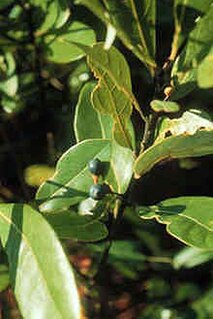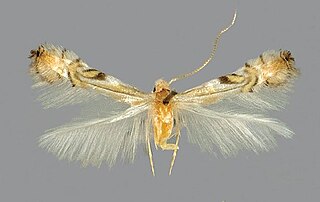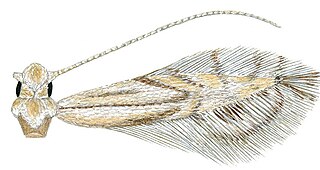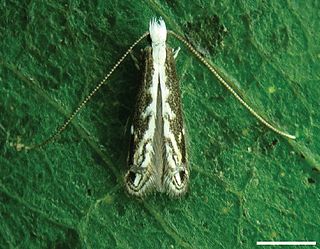| Phyllocnistis hyperpersea | |
|---|---|
 | |
| Scientific classification | |
| Kingdom: | |
| Phylum: | |
| Class: | |
| Order: | |
| Infraorder: | |
| Family: | |
| Genus: | |
| Species: | P. hyperpersea |
| Binomial name | |
| Phyllocnistis hyperpersea Davis and Wagner, 2011 [1] | |
Phyllocnistis hyperpersea is a moth of the family Gracillariidae. It is found from Nansemond and Virginia Beach Counties in Virginia, south along the lowland Atlantic coastal region to the Florida Everglades. It might have a much wider range, since material which might belong to this species has been recorded from Honduras and Mexico.

Moths comprise a group of insects related to butterflies, belonging to the order Lepidoptera. Most lepidopterans are moths, and there are thought to be approximately 160,000 species of moth, many of which have yet to be described. Most species of moth are nocturnal, but there are also crepuscular and diurnal species.

Gracillariidae is an important family of insects in the order Lepidoptera and the principal family of leaf miners that includes several economic, horticultural or recently invasive pest species such as the horse-chestnut leaf miner, Cameraria ohridella.

Virginia, officially the Commonwealth of Virginia, is a state in the Southeastern and Mid-Atlantic regions of the United States located between the Atlantic Coast and the Appalachian Mountains. The geography and climate of the Commonwealth are shaped by the Blue Ridge Mountains and the Chesapeake Bay, which provide habitat for much of its flora and fauna. The capital of the Commonwealth is Richmond; Virginia Beach is the most populous city, and Fairfax County is the most populous political subdivision. The Commonwealth's estimated population as of 2018 is over 8.5 million.


The length of the forewings is 1.9–2.2 mm. Adults have been recorded in September, December, February, March, April, May and June in southern Florida and in June in southern Virginia.
The larvae feed on Persea americana and Persea borbonia . They mine the leaves of their host plant. The mine has the form of a long, slender, serpentine gallery, with a relatively broad, dark brownish, median frass trail, almost always located on the upper (adaxial) side of the leaf. The egg is deposited on the upper leaf surface away from the midrib. Mines begin on one side of the blade, but after much of one side is consumed, cross over near the leaf apex to the other side. The median frass line is unusually broad for a species of Phyllocnistis, resembling more that of the Chilean genus Prophyllocnistis . Pupation occurs in the lamina, away from the leaf edge in a circular nidus, similar to that fashioned by Prophyllocnistis. The serpentine portion of the mine begins as a narrow tract of about 0.3 mm wide and gradually enlarges before the pupation chamber to a width of about 2–2.5 mm. The median frass line is one fourth of the mine width in the early instars and gradually broadens to more than half the mine width.

Persea borbonia is a species of plant in the Lauraceae family, with several common names including redbay, tisswood, scrubbay, shorebay, and swampbay.

A leaf miner is the larva of an insect that lives in and eats the leaf tissue of plants. The vast majority of leaf-mining insects are moths (Lepidoptera), sawflies and flies (Diptera), though some beetles also exhibit this behavior.
Frass refers loosely to the more or less solid excreta of insects, and to certain other related matter.








